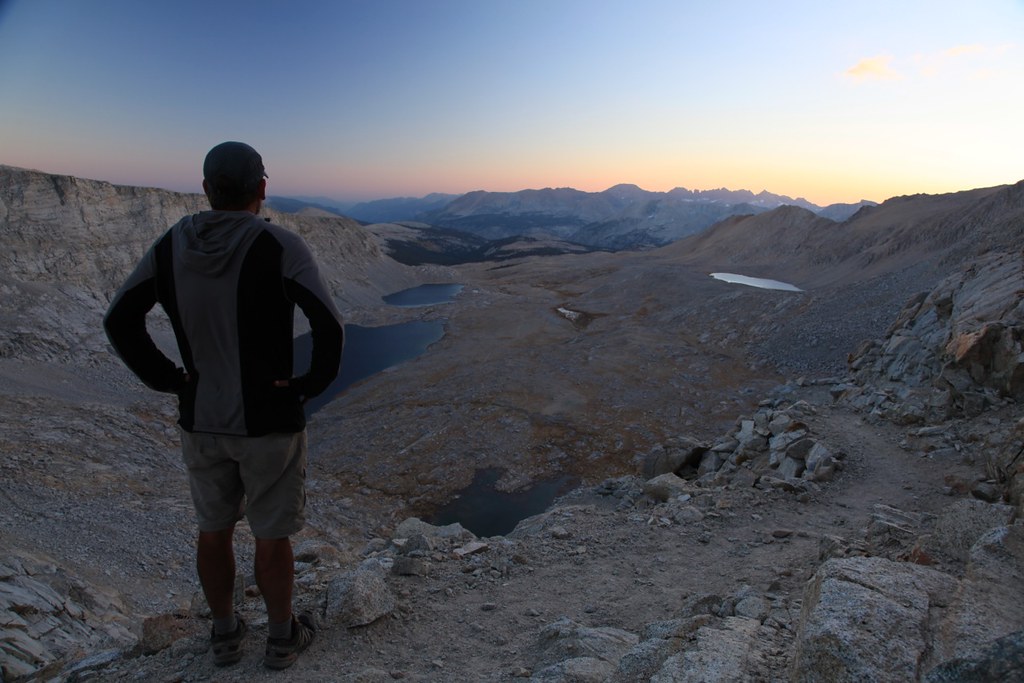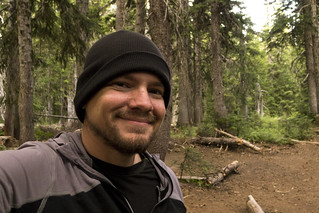 |
| (Photo: Jeffers Brook Shelter, New Hampshire) |
Shelters Vs. Tents
Victor: We are planning to do this hike in a little over 5 months as all people in our hiking party have obligations right after. With that said, do you think there is an advantage for people who tent the whole trail (vs. sleeping in shelters) as they are able to get a couple more miles of hiking in as there are more places to camp and you’re not as confined to a certain distance?
Me: First, here is an overview for people unfamiliar with the Appalachian Trail shelters. There are over 260 shelters along the AT (all built by volunteers). Most are three-walled lean-tos similar to the photo above. You will also see some with four walls, a couple are cabins, a few have fireplaces, some have bunk beds (i.e. hiker shelves), one is an old barn, and many you'll want to stay in simply for their uniqueness.
Most of the shelters have a fire ring, pit toilet, and some kind of water source nearby: a creek, spring, pond, etc. The average distance between shelters is only 8.5 miles, so other than a couple long stretches, they are close enough that you could easily hike the entire Appalachian Trail without a tent.
A few of the shelters in New Hampshire and Vermont have fees, but nearly all of them are free of charge. New Hampshire has some other differences that I’ll talk more about below.
Will shelters reduce the number of miles you hike?
Overall, I'd say no. More often than not, they pushed me to go further. If I knew a shelter was only a few more miles ahead, I'd keep going even if I was ready to stop.
I also didn't mind hiking to a shelter well after dark, because I didn't have to worry about finding a campsite and a water source before sundown. You'll also spend less time taking down camp in the morning if you stay in a shelter.
Another reason to stay in shelters is to get to know other thru-hikers. Even though I guarantee you’ll have some snorers, and a few mice, you'll meet a lot of great people in AT shelters. If you’re as lucky as me, you’ll find some of your best friends in there. (I'm talking about you, Drifters. You know who you are.)
There is nothing like the shelter system on the AT, and in my opinion, they are an essential part of the full AT experience.
Having said all that, you may want to tent more often in the first couple of weeks. The trail might be crowded for you in the beginning, since a majority of thru-hikers start at Springer Mountain in March. During this time, some hikers will end days early to guarantee a spot in a shelter, and many will end their days earlier at first until they are in better shape and have reduced their pack weight.
It won’t be crowded for long, though. Hikers will eventually put more distance between one another and as many as one-fourth will drop out in the first two weeks.
Another reason to occasionally skip the shelters is that some of your best memories will come from things like cowboy camping under the stars on a treeless mountaintop, spending a night alone deep in the woods, or finding a stealthy place to sleep in a town.
New Hampshire
New Hampshire has some differences that I wanted to point out. First, don’t plan on hiking through the whole state of New Hampshire without a tent, unless you want to pay. There are numerous campsites, shelters, and huts in New Hampshire that have a fee, primarily around the White Mountains. Although, you don't have to stay at these pay sites. There are plenty of free places to camp, as long as you are below tree line.
The hut system in New Hampshire is unique to the AT as well. They are small cabins or lodges in the White Mountains. They can cost over $100 per night, which includes dinner and breakfast, but if you get to one early enough you might be able to do “work-for-stay.”
The caretakers will usually let two to four thru-hikers in the huts for free, as long as you stick around to wash dishes, make beds, sweep the floors, or give a talk to their guests about your experiences on the AT.
The best part is they’ll also feed you for free. Since the huts are in the middle of protected forests, the caretakers have to carry out all the leftovers. They really don’t want to do that, so they'd prefer to let you eat them. Even if you don’t do work-for-stay, they may give you some leftovers if you stop in and ask. Actually, I met one hiker whose only work-for-stay job was to eat all the ham they had left!
Tips for getting work-for-stay
You can increase your chances of getting work-for-stay if you arrive early, but not too early. If they think you have enough time to get to the next hut, they'll tell you to keep going. If you get there too late, other thru-hikers will beat you to it. So, lets say, you stop at a hut that is six miles from the next hut. They will probably start accepting work-for-stay two to three hours before sundown.
If there are still four of you in the group when you get to New Hampshire, you will have better luck if you split up into two groups of two. If you don't get work-for-stay, ask them if you can setup camp nearby and at least work for a meal.
The best hut for northbounders to stay at is the Lake of the Clouds hut. It's located at the base of Mount Washington, and the remaining section of trail in the Presidential Range. Since you can't camp above tree line in this area, it's a great place to end your day, so you can easily get through this section by nightfall the following day. The good news is, this hut allows ten hikers to stay in their basement (lovingly called The Dungeon). Additionally, because of its location, northbounders will get dibs.
My final tip, if you do get work-for-stay, go out of your way to do a great job and you might be able to guarantee a spot in one of the other huts. The caretakers at the Mizpah Hut gave Red and I the task of shaking the dust out of all their blankets, sweeping the floors afterwards, and then folding the blankets. Two hours later, they told us we worked long enough and could leave, but we insisted on staying until the job was done. Before we left, they asked if we could deliver a sealed note to the next hut.
When we arrived, there were already four thru-hikers out front who said the hut was full. Red and I walked in to deliver the note to a caretaker. He read it then looked up and said, “So, do you guys want to stay here tonight?”
Red happened to get a look at the note. It said, “These guys do kick ass work!”
In Conclusion
So, my recommendation is to mix it up. Experience it all. Stay in shelters, setup camps next to sunset views, cowboy camp around a fire, sleep on mountain tops without a tent and fall asleep while staring at the stars. When in town, find random places to sleep, stay in hostels. or split the cost of a hotel room with other hikers. It's also likely that you'll meet strangers along the way and get invited to stay in their homes.
As long as you occasionally calculate the average daily miles you need to finish by your deadline, you’ll naturally do what you have to do to finish. Nothing will compare to the emotion you will feel when you get to Katahdin, but that isn’t the only thing you’ll remember. It will be the people you met and the places you spent the night that you’ll talk about for years.
Since this is the last question, here are a few last bits of advice.
If you feel terrible, or the weather is making you miserable, take a day or two off. And don't feel guilty about it. A day off is better than being so miserable that you think about going home. I found that once that thought got into a thru-hiker's mind, it was only a matter of time before they headed home.
Avoid Branchville, New Jersey. It seems like a convenient place to resupply, but just walk on by. Especially the Joe-to-Go coffee and sandwich shop. He has a well-known reputation for despising hikers and treating them like garbage. There are forums at whiteblaze.net devoted to altercations with that guy.
Take pictures of people. Landscape shots are great, but after your hike, you'll be glad you took photos of the people you met. They, more than the views and the miles, will define your experience on the AT.
Finally, don't skip any miles. They say about 1 in 5 will finish the trail, but it's actually much less than that. Most hikers I met skipped large sections of trail. The feeling at the end will be much greater if you know you passed every white blaze.
I had to skip a section after damage from Hurricane Irene closed down the Green Mountains National Forest. I regretted it the whole trip. I wished I would have risked the $5000 fine that they threatened to impose if we were caught in the park. I eventually went back the following April and finished that section when I hiked the Long Trail in Vermont. That turned my disappointment into another great trip, so I don't regret it anymore. However, if you're ever tempted to skip even one mile, ask yourself how you'd feel if you stopped one mile from Katahdin.
Victor, thanks for giving me the opportunity to answer your questions and good luck on your journey! It will be one of the most memorable five months of your life. I look forward to reliving the experience through your stories.
Once again, you can follow Victor and his friends on their AT journey at BackpackingAT.com.
More Q&As with Victor:
Bugs and other Pests on the Appalachian Trail
Weather and Morale on the Appalachian Trail
Knives on the Appalachian Trail
Hiking with Visitors on the Appalachian Trail
Online Mail Drops on the Appalachian Trail
Victor: We are planning to do this hike in a little over 5 months as all people in our hiking party have obligations right after. With that said, do you think there is an advantage for people who tent the whole trail (vs. sleeping in shelters) as they are able to get a couple more miles of hiking in as there are more places to camp and you’re not as confined to a certain distance?
 |
| (Photo: Overmountain Shelter, Tennessee) |
 |
| (Photo: Chatfield Memorial Shelter, Virginia) |
A few of the shelters in New Hampshire and Vermont have fees, but nearly all of them are free of charge. New Hampshire has some other differences that I’ll talk more about below.
 |
| (Photo: The 501 Shelter, Pennsylvania) |
Overall, I'd say no. More often than not, they pushed me to go further. If I knew a shelter was only a few more miles ahead, I'd keep going even if I was ready to stop.
I also didn't mind hiking to a shelter well after dark, because I didn't have to worry about finding a campsite and a water source before sundown. You'll also spend less time taking down camp in the morning if you stay in a shelter.
 |
| (Photo: Spruce Peak Cabin, Vermont. My favorite Shelter!) |
There is nothing like the shelter system on the AT, and in my opinion, they are an essential part of the full AT experience.
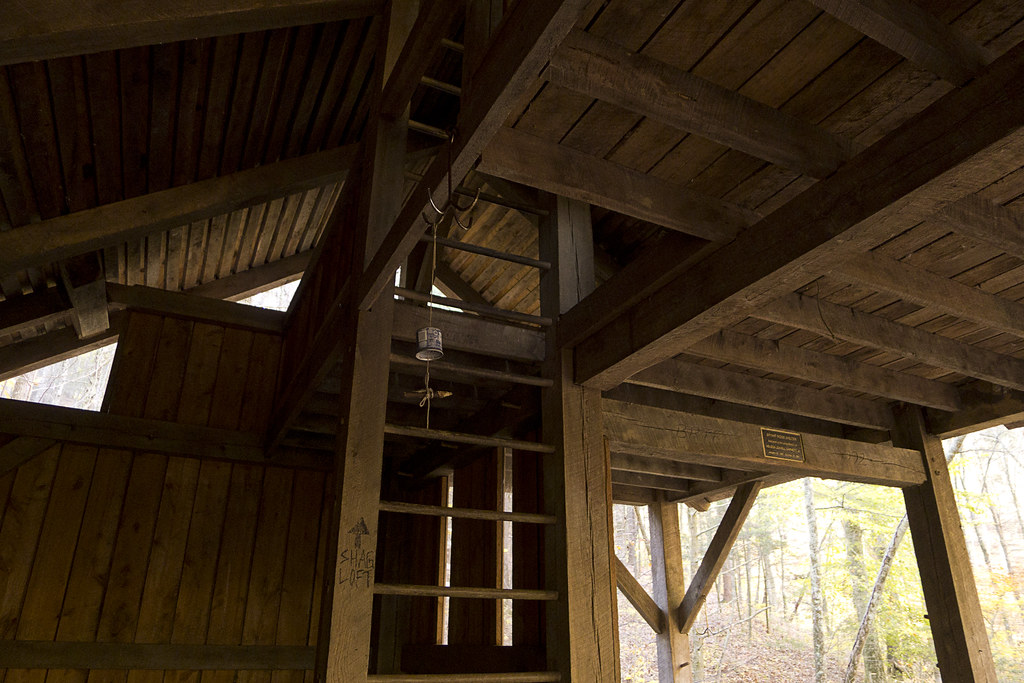 |
| (Photo: Shelter with a loft in Virginia) |
It won’t be crowded for long, though. Hikers will eventually put more distance between one another and as many as one-fourth will drop out in the first two weeks.
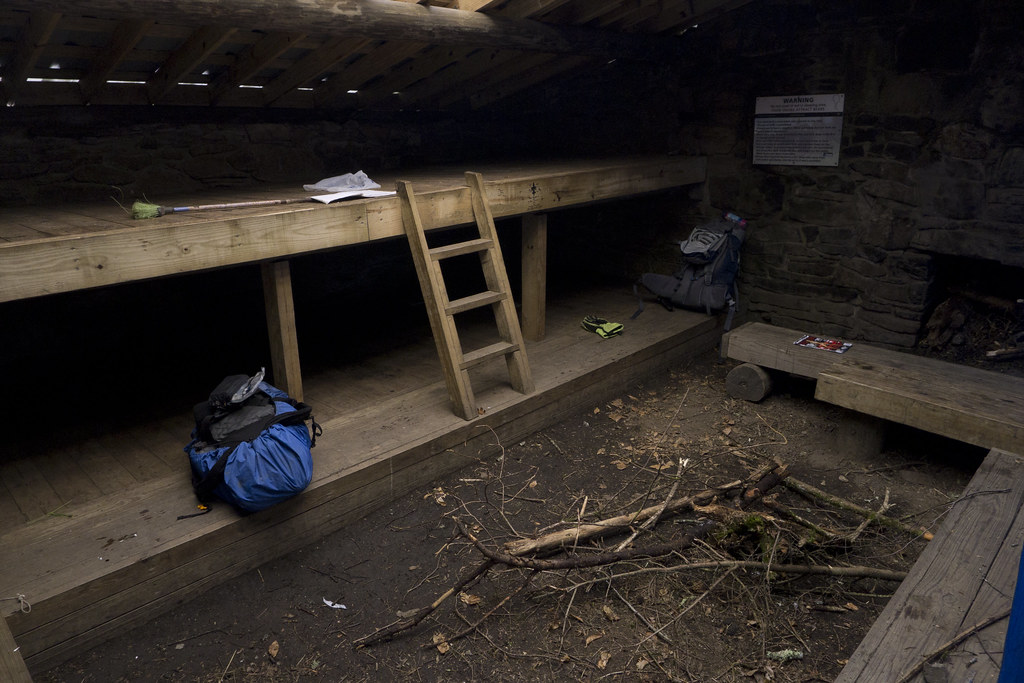 |
| (Photo: Smoky Mountain Shelter, in Tennessee, with a fireplace) |
 |
| (Photo: Slept behind an abandoned bank in NH) |
New Hampshire has some differences that I wanted to point out. First, don’t plan on hiking through the whole state of New Hampshire without a tent, unless you want to pay. There are numerous campsites, shelters, and huts in New Hampshire that have a fee, primarily around the White Mountains. Although, you don't have to stay at these pay sites. There are plenty of free places to camp, as long as you are below tree line.
 |
| (Photo: NH's Zealand Hut) |
The caretakers will usually let two to four thru-hikers in the huts for free, as long as you stick around to wash dishes, make beds, sweep the floors, or give a talk to their guests about your experiences on the AT.
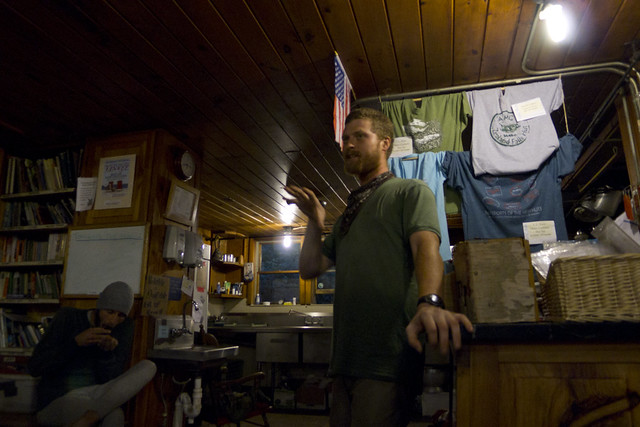 |
| (Photo: Red giving a speech for his work-for-stay) |
Tips for getting work-for-stay
You can increase your chances of getting work-for-stay if you arrive early, but not too early. If they think you have enough time to get to the next hut, they'll tell you to keep going. If you get there too late, other thru-hikers will beat you to it. So, lets say, you stop at a hut that is six miles from the next hut. They will probably start accepting work-for-stay two to three hours before sundown.
If there are still four of you in the group when you get to New Hampshire, you will have better luck if you split up into two groups of two. If you don't get work-for-stay, ask them if you can setup camp nearby and at least work for a meal.
The best hut for northbounders to stay at is the Lake of the Clouds hut. It's located at the base of Mount Washington, and the remaining section of trail in the Presidential Range. Since you can't camp above tree line in this area, it's a great place to end your day, so you can easily get through this section by nightfall the following day. The good news is, this hut allows ten hikers to stay in their basement (lovingly called The Dungeon). Additionally, because of its location, northbounders will get dibs.
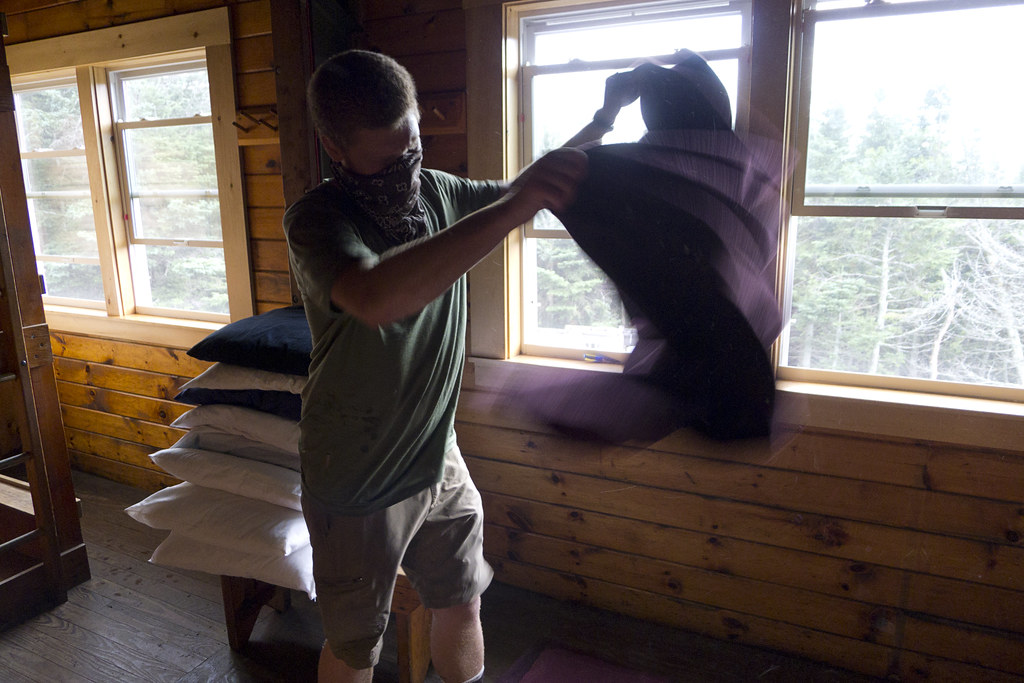 |
| (Photo: Red doing work-for-stay) |
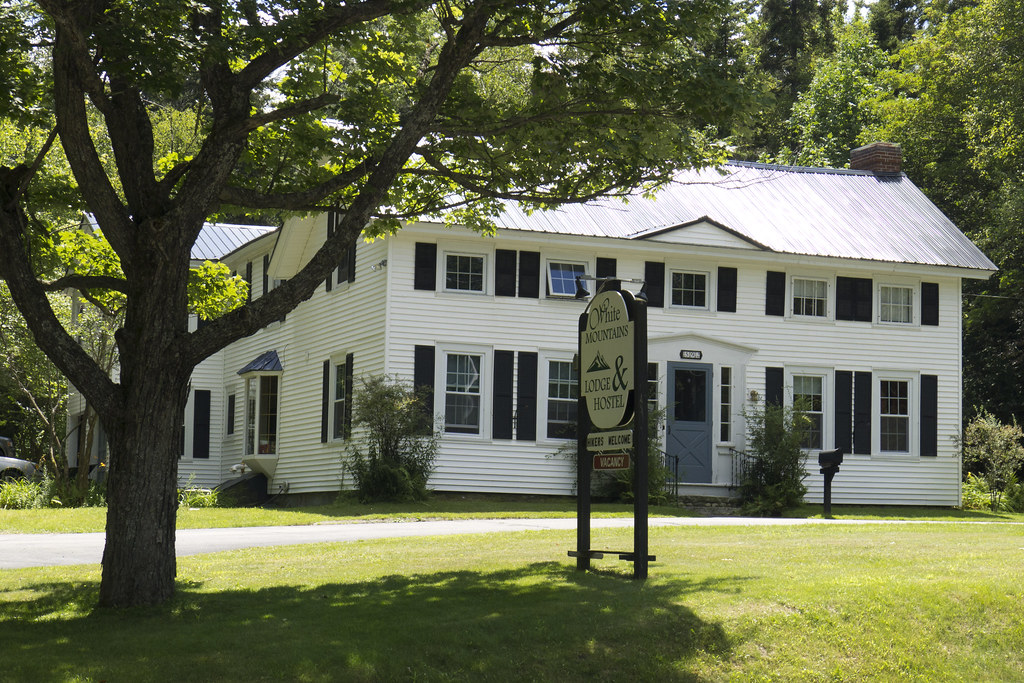 |
| (Photo: White Mountain Hostel in NH. My favorite hostel anywhere.) |
Red happened to get a look at the note. It said, “These guys do kick ass work!”
 |
| (Photo: Slept in a dugout in Maine) |
So, my recommendation is to mix it up. Experience it all. Stay in shelters, setup camps next to sunset views, cowboy camp around a fire, sleep on mountain tops without a tent and fall asleep while staring at the stars. When in town, find random places to sleep, stay in hostels. or split the cost of a hotel room with other hikers. It's also likely that you'll meet strangers along the way and get invited to stay in their homes.
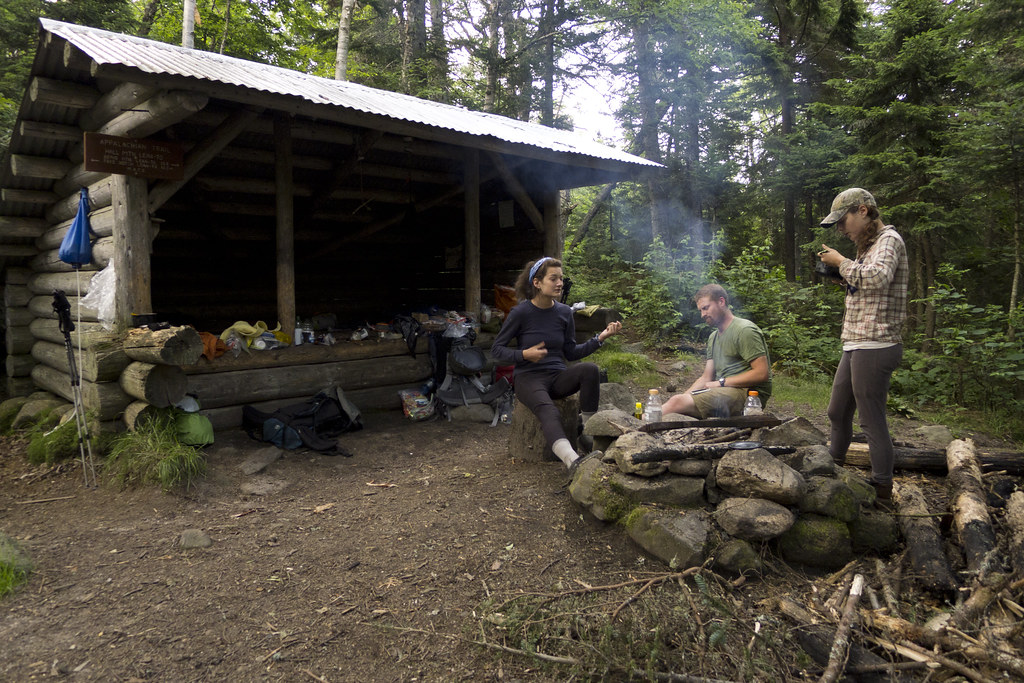 |
| (Photo: Some of my favorite people I met in a shelter) |
- - -
Since this is the last question, here are a few last bits of advice.
If you feel terrible, or the weather is making you miserable, take a day or two off. And don't feel guilty about it. A day off is better than being so miserable that you think about going home. I found that once that thought got into a thru-hiker's mind, it was only a matter of time before they headed home.
Avoid Branchville, New Jersey. It seems like a convenient place to resupply, but just walk on by. Especially the Joe-to-Go coffee and sandwich shop. He has a well-known reputation for despising hikers and treating them like garbage. There are forums at whiteblaze.net devoted to altercations with that guy.
Take pictures of people. Landscape shots are great, but after your hike, you'll be glad you took photos of the people you met. They, more than the views and the miles, will define your experience on the AT.
Finally, don't skip any miles. They say about 1 in 5 will finish the trail, but it's actually much less than that. Most hikers I met skipped large sections of trail. The feeling at the end will be much greater if you know you passed every white blaze.
I had to skip a section after damage from Hurricane Irene closed down the Green Mountains National Forest. I regretted it the whole trip. I wished I would have risked the $5000 fine that they threatened to impose if we were caught in the park. I eventually went back the following April and finished that section when I hiked the Long Trail in Vermont. That turned my disappointment into another great trip, so I don't regret it anymore. However, if you're ever tempted to skip even one mile, ask yourself how you'd feel if you stopped one mile from Katahdin.
Victor, thanks for giving me the opportunity to answer your questions and good luck on your journey! It will be one of the most memorable five months of your life. I look forward to reliving the experience through your stories.
Once again, you can follow Victor and his friends on their AT journey at BackpackingAT.com.
More Q&As with Victor:
Bugs and other Pests on the Appalachian Trail
Weather and Morale on the Appalachian Trail
Knives on the Appalachian Trail
Hiking with Visitors on the Appalachian Trail
Online Mail Drops on the Appalachian Trail
A Backpacker's Life List by Ryan Grayson is licensed under a
Creative Commons Attribution-NonCommercial-NoDerivs 3.0 Unported License.
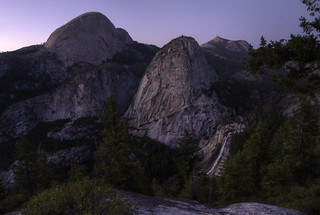
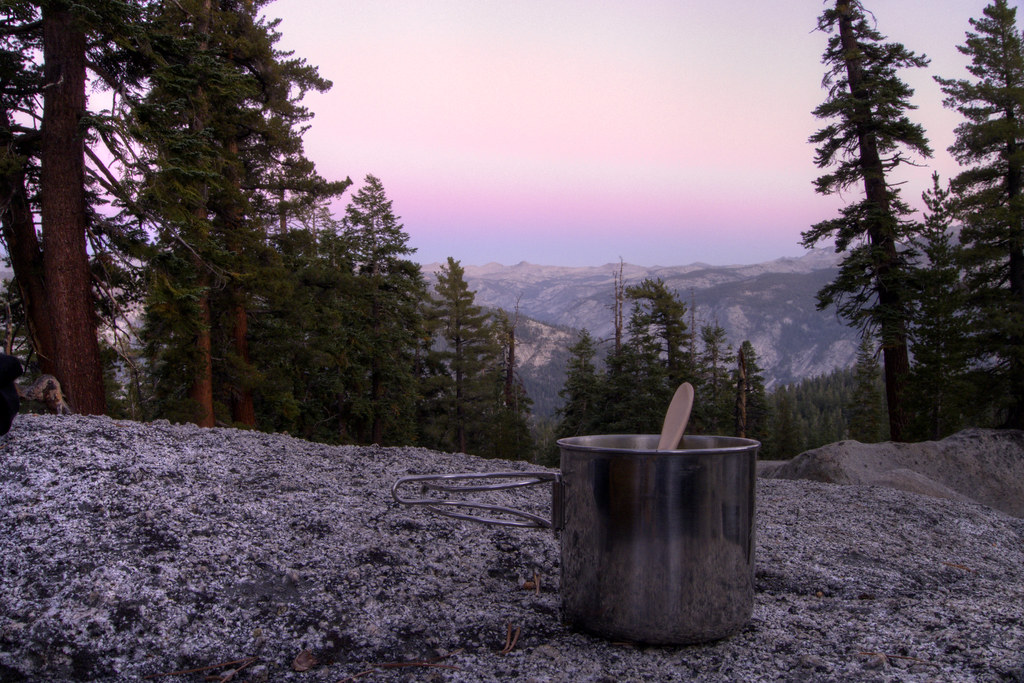
com-s.jpg)
com-s.jpg)
com-s.jpg)
com-s.jpg)
